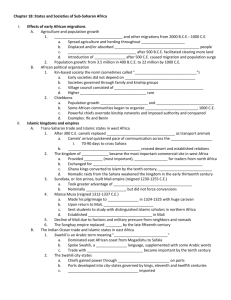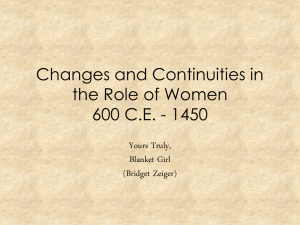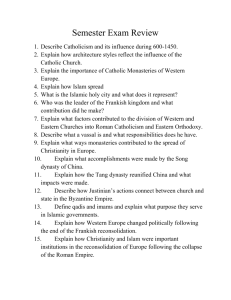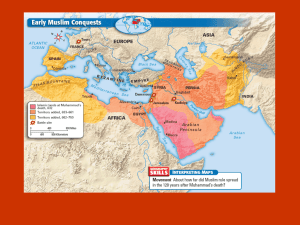Women in African Muslim Societies, 1400-1700
advertisement
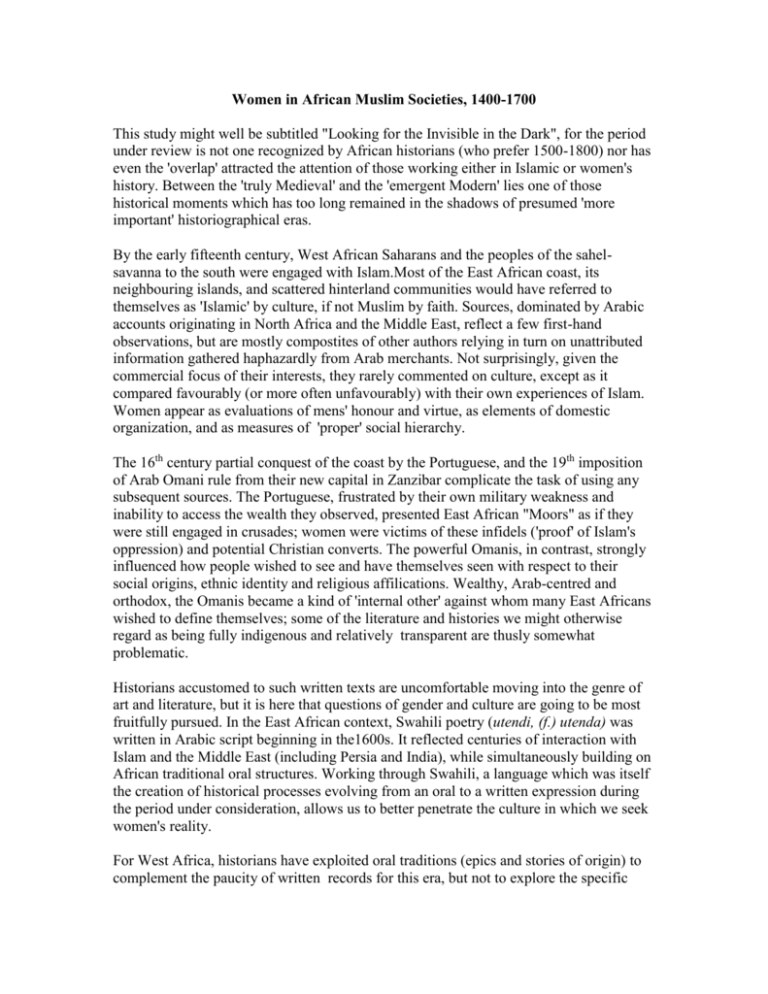
Women in African Muslim Societies, 1400-1700
This study might well be subtitled "Looking for the Invisible in the Dark", for the period
under review is not one recognized by African historians (who prefer 1500-1800) nor has
even the 'overlap' attracted the attention of those working either in Islamic or women's
history. Between the 'truly Medieval' and the 'emergent Modern' lies one of those
historical moments which has too long remained in the shadows of presumed 'more
important' historiographical eras.
By the early fifteenth century, West African Saharans and the peoples of the sahelsavanna to the south were engaged with Islam.Most of the East African coast, its
neighbouring islands, and scattered hinterland communities would have referred to
themselves as 'Islamic' by culture, if not Muslim by faith. Sources, dominated by Arabic
accounts originating in North Africa and the Middle East, reflect a few first-hand
observations, but are mostly compostites of other authors relying in turn on unattributed
information gathered haphazardly from Arab merchants. Not surprisingly, given the
commercial focus of their interests, they rarely commented on culture, except as it
compared favourably (or more often unfavourably) with their own experiences of Islam.
Women appear as evaluations of mens' honour and virtue, as elements of domestic
organization, and as measures of 'proper' social hierarchy.
The 16th century partial conquest of the coast by the Portuguese, and the 19th imposition
of Arab Omani rule from their new capital in Zanzibar complicate the task of using any
subsequent sources. The Portuguese, frustrated by their own military weakness and
inability to access the wealth they observed, presented East African "Moors" as if they
were still engaged in crusades; women were victims of these infidels ('proof' of Islam's
oppression) and potential Christian converts. The powerful Omanis, in contrast, strongly
influenced how people wished to see and have themselves seen with respect to their
social origins, ethnic identity and religious affilications. Wealthy, Arab-centred and
orthodox, the Omanis became a kind of 'internal other' against whom many East Africans
wished to define themselves; some of the literature and histories we might otherwise
regard as being fully indigenous and relatively transparent are thusly somewhat
problematic.
Historians accustomed to such written texts are uncomfortable moving into the genre of
art and literature, but it is here that questions of gender and culture are going to be most
fruitfully pursued. In the East African context, Swahili poetry (utendi, (f.) utenda) was
written in Arabic script beginning in the1600s. It reflected centuries of interaction with
Islam and the Middle East (including Persia and India), while simultaneously building on
African traditional oral structures. Working through Swahili, a language which was itself
the creation of historical processes evolving from an oral to a written expression during
the period under consideration, allows us to better penetrate the culture in which we seek
women's reality.
For West Africa, historians have exploited oral traditions (epics and stories of origin) to
complement the paucity of written records for this era, but not to explore the specific
themes of Islamization and women. Saharan stories intended to legitimate a clan's
economic or political position, take Muslim heritage for granted; they are buttressed by
geneaologies that omit female family members. Women appear as slaves, concubines or
the 'cause' of conflict generating tribal divisions. Here too, a major art-form is poetry
composed in the Arabic-Berber dialect hassanya; relatively little has been recorded, even
less plumbed by historians, although it has long been Saharans’ preferred manner of
'remembering' and teaching about the past . A whole genre is composed in the context of
'love', offering insights into gender relationships which could yet be useful. South of the
Sahara, traditions are more often of the poetic, 'epic' genre, rich in metaphor, nuanced in
meaning but potentially more revealing of gender relations and women's roles than the
external sources interested in primarily in male-dominated trade and politics. However,
the literacy which accompanied Islam meant that as some of these epics were written for
the first time, they acquired an 'Islamic gloss': patrilineal practices, women's veiling and
seclusion, lawful treatment of slaves and concubines were emphasized. This tendency
was accentuated from the late 18th century as reformist movements, jihads, spread across
West Africa. Colonial European sources, in turn, frequently attributed the weight of
authenticity to these written variations in their own interpretations, further complicating
our task of interrogating early 'oral' traditions.
Contemporary secondary histories of these regions argue that the most significant change
occuring prior to the 18th century was the strengthening of Islam: as Islam increasingly
‘gained hold’ of society, women increasingly ‘lost access to’ personal and political
power. This personifying of ‘Islam’ simultaneously privileges male voice and obscures
female actions of 'choice'. Between 1400 and 1700, West and East African societies were
challenged by the destablizing effects of internal warfare, prolonged droughts, and
population fluctuations; they also addressed the transforming impact of international
trade (including the slave trades). Islam was absorbed and nurtured in very particular,
indeed personal, ways by societies and peoples whose experiences in this context varied
widely. Class and gender feature prominently in explaining these differences.
The most visible women are slaves: domestic slaves prepared and served food; female
slaves spun cotton in Senegambia (West Africa), and slaves (including women)
outnumbered "Moors" on farms and in palm groves around Kilwa and Mombassa (East
Africa). But most commented upon are concubines. In West Africa’s Ancient Mali, royal
concubines in the 13th century wore fine clothes and jewels; 1000s of them accompanied
Mansa Musa on his famous pilgrimage through Egypt. A late 15th century ruler of Kano
(Hausaland) announced his 'commitment' to Islam by ordering the catching of girls and
women to populate his new harem. And a famous 17th century Swahili utendi, 'Lament to
Greatness', spoke of a declining urban civilization which had once known "harem
chambers" ringing with laughter and the talk of slaves. There is nothing intrinsically
Islamic about this upper-class concubinage, but there may have been a growing sense that
the taking of female slaves should follow Muslim law, sharia. Mansa Musa was informed
by Egyptian scholars that if he 'possessed' the beautiful daughters offered to him by his
subjects, he must marry them; however, he was permitted only four such wives. Only
slaves could be concubines and free women could not be treated as slaves. A 15th century
ruler of Songhay (Mali's successor) consulted a North African scholar: slave girls, sold
2
and then married to the purchaser, were frequently already pregnant; quarrels then
errupted between the merchants. For the theologian, most important was the fact that
sharia stipulated sold slave girls should be placed in the care of a trustworthy man until
their next menstration in order to assure that they were not already pregnant (muwada’a);
and it was the responsibility of good Muslim rulers to enforce this law. The implication
here is a recognized responsibility on the part of the 'father' not to sell the mother of his
child, umm al- walid. We can also infer from this exchange that female slaves were
sometimes married, becoming actual 'wives'; both marriage and concubinage provided
immediate social mobility and the potential of freedom if sharia was respected. That this
was not always the case is revealed in the epic of a Malian ruler who had not treated his
slave concubine well. She was forced to raise her son a slave. As a man, he brought civil
war to the land in the quest for his 'rightful' power.
The 'moral' of the otherwise traditional story of succession reflects a strong cultural
recognition of Islamic values betrayed, a 'gap' between internalizing and implementing
sharia which may have become especially significant where it involved the treatment of
women. One of the first signifiers of a 'truly' converted ruler was the restriction of his
wives to four -- and invariably the expansion of his slave harem. Early accounts from
both East and West Africa reveal a more subtle but equally important aspect of 'Islamic'
gender relations: foreign merchants established themselves locally by marrying free
women to gain access to land and power; they took concubines in order to have children.
Whether women were destined to wear silks and jewels was not a function of being free
or slave; it mattered more whether they were rural or urban, rich or poor -- slaves had
more opportunity for social mobility than poor, free women. The role of the concubine
was also critical: her children were the progeny of their father; she had no family to claim
either child or inheritances on his/her behalf. Local noble women may have become
increasingly less valued as mothers; frequent descriptions of dark and 'black Moors' in
East African accounts, as well as observations in later centuries of 'black' bidan (Saharan
nobles) are suggestive of such a trend.
The significance of these observations is underscored by the fact that these host African
societies were matrilineal. Ibn Battuta noted that in the Sahara a man's heirs were the
sons of his sister, and women had higher status than men; 'legitimacy' in the oral epics to
the south was almost always expressed through female kin relations; and in East Africa,
coastal traditions reveal early matrilineal inheritance patterns, while research in the
hinterland shows land was inherited through female lineages. It is argued however, that
as these societies became more Islamic, they became patrilineal; women lost the powers
associated with matrilineality. But even somewhat coloured 'evidence' suggests
otherwise. Oral traditions recounting the decline of Ancient Ghana reflect continuing
matrilineal succession in spite of adoption of Islam by the state. Seventeenth-century
Saharan genealogies were rewritten to 'prove' patrilineal descent, but their oral histories
and poetry continued to betray matrilineal values. One well known East African epic
about a struggle over power between a brother and half-brother is centred on the tension
between the older African tradition of succession and the newer Islamic one, the latter
dominates only belatedly. In one coastal region, the Muslim 'sultan' descended through
3
the African female line for seven generations before a daughter took an Arab husband
and it appears that patrilineal succession begin.
But it is not clear that women were excluded entirely from politics, even over time. In
West Africa, marriages continued to cement alliances between Saharan clans, as well as
powerful 'emirs' through the 19th century. Clan histories of origin and migration feature
women as 'causes' of conflict but also as the means by which reconciliation later occurs.
A late 15th century Queen of Hausaland, immortalized in a poem referencing her mortar
of 'scented Guinea wood' and her pestle of 'solid silver', is called both (Muslim)
"Amina" and (African)"Gumsa"; in asking Allah to give her the long life of a frog and the
dignity of an eagle, the poet collapses into one cultural identity and definition of power in
belief systems of two different but not necessarily competing worlds. Equally telling are
the oral epics in which 'political power' remains inextricably tied to occult powers: battles
are won with magic and the source of magic is inevtiably a powerful woman. Women (or
their symbols -- food, mortars and pestles) appear as mothers, daughters, sisters and
sirens, dynamic catalysts to men's actions who, like Saharan women, re-appear to 'accept
the responsibility' imposed by such power. Some later manuscript versions, like those of
the famous Sonjata, founder of Ancient Mali, attempt to displace the importance
accorded to the hero’s mother and female kinfolk. In this case, crippled Sonjata's
miraculous cure derives from a token taken from his father, rather than his mother; his
sister ceases to have a role in his final taking of power. This kind of 'Islamisation of the
past' is revealing, suggesting (as do traditions that retain a matrilineal social discourse)
that societies may not yet have been as reformed in the Islamic patrinlineal image as
historians have assumed. Sometimes it was necessary for traditional historians to re-write
matrilineal conceptions of origin in order to create contemporary patrilineal identities and
facilitate the legitimizing of 'proper' Muslim power.
Female rulers and regents, some combining African titles with Arab Muslim names,
others being either purely African or Arab, continue to appear through the early 18th
century in East African chronicles. One tradition celebrates the winning of power from
one such Queen by a sultan who was himself the son of a humble woman. She had been
the daughter of a fisherman, serendipitously 'discovered' by the sultan in answer to her
father's prayers to Allah -- a 'legitimation' of the throne through a mother which makes
sense only when read through a matrilineal lens. Less obtuse are five seventeenth-century
coastal epitaphs commemorating woman rulers, convincing evidence, suggests one
scholar, that we may have be mistaken in regarding women as a "suppressed class".
We need to dispense with both notions: women as 'class', women as 'suppressed'. It was
precisely the diversity of classes to which women belonged which shaped their varied
adoptions of, and adaptations to, Islam. "Suppression" reflects a contemporary
(mis)valuing of Islam which in turn distorts the way we ask our questions of women's
experience. In East African sources we glimpse wealthy wives, royal women and the
female slaves of their households. The poor (free and non-free), the rural, the kin of
artisans, petty traders, fisherman and sailors are invisible except when fate brings them
into the realm of the 'important'. Thus, we meet a fisherman's daughter because she
became a queen; the wive of an artisan because she was taken concubine to the Sultan,
4
the Pate chronicle remembers her 'freeman' husband seeking revenge; the anonymous
women of Malindi and Mombassa because the Portuguese recounted how they resisted or
embraced (respectively) conversion to Christianity. West African Arabic sources rarely
describe anyone who is neither royal nor slave and in oral epics, excepting slaves and
servants mentioned incidently, women are uniformly identified by their kin roles. They
remain undifferentiated except in terms of magical power, significant but still leaving the
majority of women invisible.
But we also aggrevate these intrinsic problems by rooting questions in contemporary
perceptions -- like the notion of Muslim women as an 'oppressed class'. We measure
Islam by the practises of seclusion (purdah) and veiling, although these were clearly not
signifiers even for the prudish Ibn Battuta. The introduction of purdah is attributed to the
same 15th century Hausa-Kano king who ordered the 'catching of women and girls' as
concubines and the taking of 1000 'first-born virgins' as wives -- a notable contrevention
of sharia, in spite of his 'purifying' reputation. Female seclusion among wealthy Hausa
survived into the early twentieth century; yet by the 19th century, another Muslim purist
bewailed the fact women in Hausaland no longer knew the basic teachings of their
religion, including prayers. Men had 'abused' the notion of submission to Allah in
demanding women’s unquestioning obedience in the guise of housework! In East Africa,
there is no evidence that Islam brought veiling or seclusion to women. One Portuguese
source mentioned that the 'Moors' "shut up" their wives, but the many accounts of finely
dressed women, observant of skin colour and jewellery, belie the existence of general
veiling and purdah even among the wealthy Swahili. The utendi "Lament for Greatness"
implies the existence of gendered living space ("men's halls", "harem chambers") as does
historical architectural research in the Kano palace, but this is neither synonymous with
seclusion nor particular to Islam; its significance in terms of our subject matter has yet to
be explored. And as for veiling, one scholar suggests that it was not Islamic but cultural
in origin: early "Shirazi" settlers did not veil but the Arab immigrants seeking social and
political ascendancy during the 16th and 17th centuries did. Veiling was a measure of their
social and cultural status vis-à-vis local Swahili and Africans.
Recent research raises other issues. One famous 17th century utenda appears to be
instructions from a mother to her daughter on how to be a good, submissive wive. Once
received as 'evidence' of female oppression, it has recently been interpreted by a scholar
who understands the literary form (as well as the words) as being a work of irony and
sarcasm -- an expression of mockery for the 'power' supposed to be in the hands of male
spouses and rulers -- 'veiled' by literary tradition to all but those who were intended to
understand it. Not only does this approach open new windows on the accomplishments of
women poets, for it appears that upper class women were generally educated and often
adept at utenda, it suggests the existence of a female discourse negotiating the arena of
social relationships in ways and with goals we have yet to understand. Research in parts
the more rural hinterland shows a continuity of matrilineality: women did not marry
'down', marriages strengthened female lines, town and village 'wards' were defined and
dominated by female lineages, and land remained in their control. Men used their
religious roles to establish a kind of parallel system of power rooted in the mosque, which
ultimately came to complement the strength of matrilineality.
5
The received wisdom that Islam's 'penetration' was about male traders and clerics, and
Islam's 'strength' was in the hands of sultans and ulama overlooks the fact that in Africa's
matrilineal societies, women were in the position to shape how Islam would be integrated
into local culture and politics. As mothers, wives, sisters, daughters and slaves they had
many ways to influence society. That matrinlineality both competed with and
accomodated Islam's patrilineal infrastructure, and that the 'extra-Islamic' power of
magic and local cults associated with women remained important to the practice of Islam,
should not be surprising. Integrating different belief systems and creating new,
sometimes parallel power structures within society and culture were not evidence of
'inferior' or 'regressive' Islam. More often, they reflected responses of women to real
social change generated by combinations of internal dynamcis and external factors. We
should not be looking at Islamic culture in Africa as something imposed, measured
against signifiers like seclusion and veiling; rather, we should be seeking women's
historical experiences, as we have tried to do here, in order to understand just what
constituted Islamic culture in any given time and place.
(3020 words)
6




